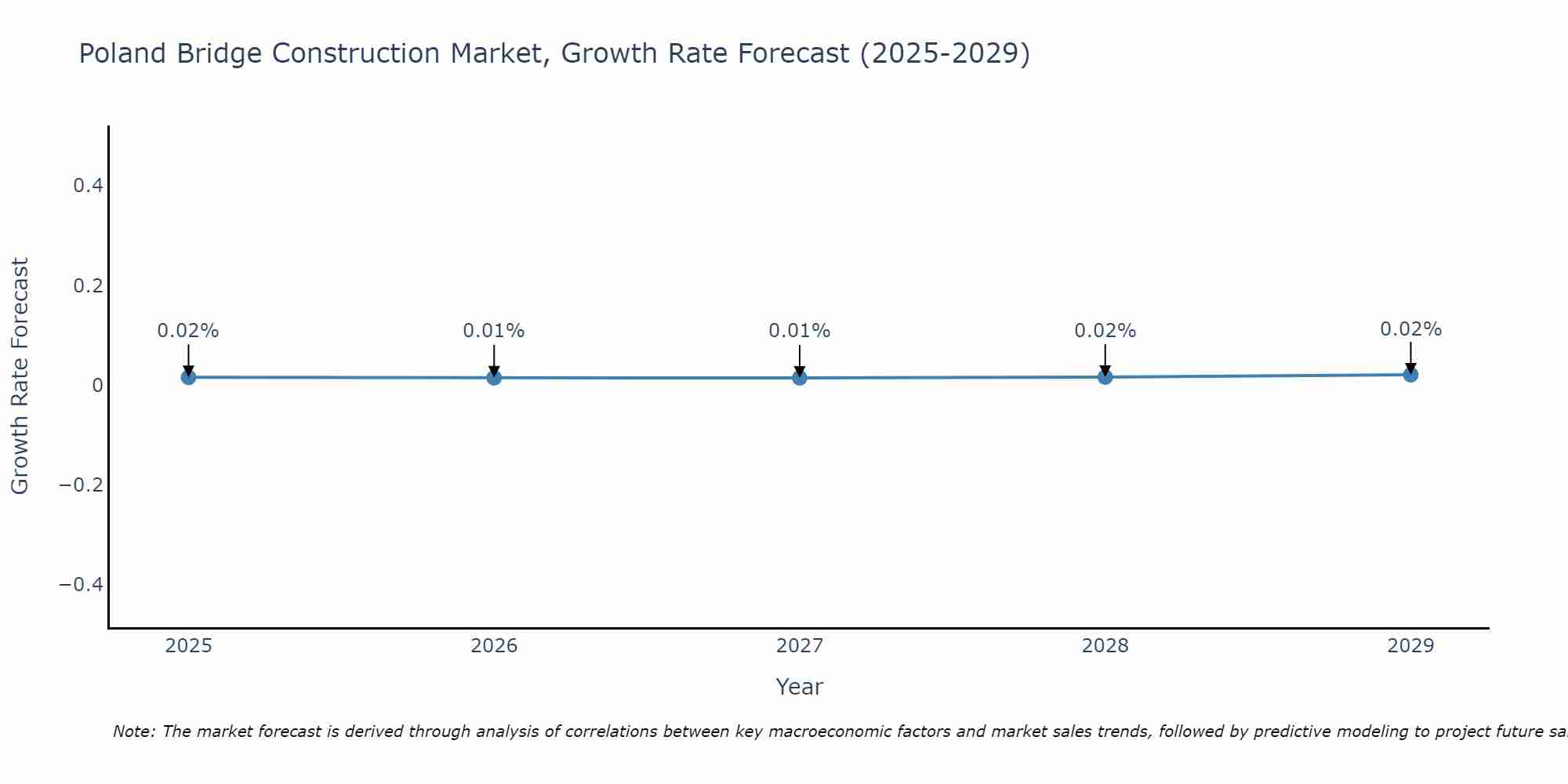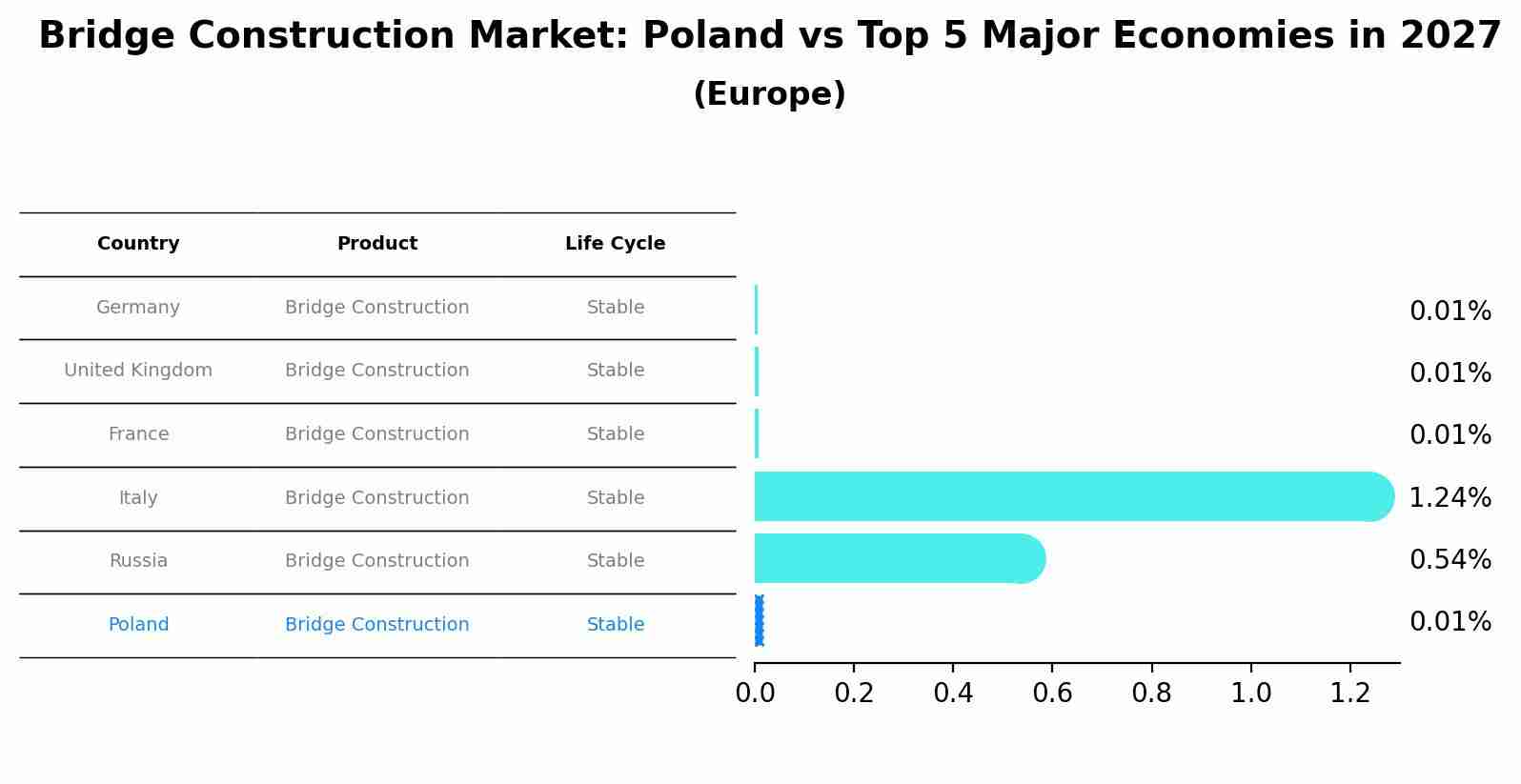Poland Bridge Construction Market Outlook | Companies, Share, Growth, Industry, Size, Analysis, Value, Forecast, Revenue, Trends & COVID-19 IMPACT
| Product Code: ETC360075 | Publication Date: Aug 2022 | Updated Date: Aug 2025 | Product Type: Market Research Report | |
| Publisher: 6Wresearch | Author: Sachin Kumar Rai | No. of Pages: 75 | No. of Figures: 35 | No. of Tables: 20 |
Poland Bridge Construction Market Size Growth Rate
The Poland Bridge Construction Market is projected to witness mixed growth rate patterns during 2025 to 2029. From 0.02% in 2025, the growth rate steadily ascends to 0.02% in 2029.

Bridge Construction Market: Poland vs Top 5 Major Economies in 2027 (Europe)
By 2027, Poland's Bridge Construction market is forecasted to achieve a stable growth rate of 0.01%, with Germany leading the Europe region, followed by United Kingdom, France, Italy and Russia.

Poland Bridge Construction Market Synopsis
The Poland Bridge Construction Market is experiencing steady growth driven by increasing infrastructure development projects across the country. The market is highly competitive, with key players such as Mostostal Warszawa, Budimex, and Strabag leading the industry. Government initiatives to improve transportation networks and enhance connectivity have fueled demand for new bridge construction projects. Factors such as urbanization, population growth, and the need to replace aging infrastructure have also contributed to the market`s expansion. Technological advancements in construction materials and methods are shaping the industry, with a focus on sustainability and cost-efficiency. As Poland continues to invest in its infrastructure, the bridge construction market is expected to remain robust, offering opportunities for both domestic and international construction firms to participate in various projects.
Poland Bridge Construction Market Trends
The Poland Bridge Construction Market is experiencing several key trends. Firstly, there is a growing emphasis on sustainability and eco-friendly practices, leading to an increased demand for innovative materials and construction techniques that reduce environmental impact. Secondly, the adoption of digital technologies such as Building Information Modeling (BIM) and drones for surveying and monitoring construction progress is gaining traction, improving efficiency and accuracy in project delivery. Additionally, there is a focus on enhancing bridge infrastructure to improve connectivity and transportation networks across the country, with a particular emphasis on modernizing existing bridges to meet safety standards and accommodate growing traffic volumes. Overall, the market is moving towards more sustainable, technologically advanced, and efficient practices to meet the evolving needs of Poland`s infrastructure development.
Poland Bridge Construction Market Challenges
In the Poland Bridge Construction Market, some key challenges include strict regulatory requirements and approvals processes, limited funding and budget constraints, skilled labor shortages, and the need for innovative and sustainable construction techniques. Additionally, the market is highly competitive, with many local and international companies vying for projects. Ensuring compliance with evolving safety standards and environmental regulations while meeting project deadlines and budget constraints can be particularly daunting. The industry also faces logistical challenges in terms of sourcing materials and transporting equipment to construction sites, especially in remote or rural areas. Overall, navigating these challenges requires strategic planning, strong partnerships, and a focus on technological advancements to drive efficiency and competitiveness in the Poland Bridge Construction Market.
Poland Bridge Construction Market Investment Opportunities
The Poland bridge construction market offers promising investment opportunities due to the country`s infrastructure development initiatives and increasing demand for modern transportation networks. With the European Union funding available for infrastructure projects in Poland, there is a growing need for the construction of new bridges, rehabilitation of existing structures, and implementation of advanced technology and materials. Investors can consider opportunities in bridge design, engineering, construction materials supply, and project management services. Additionally, the focus on sustainable and innovative bridge solutions presents avenues for investments in eco-friendly construction practices and smart infrastructure technologies. Collaborating with local construction companies and leveraging expertise in bridge construction can also provide strategic entry points for investors looking to capitalize on the evolving market landscape in Poland.
Jordan Agar Market Government Policies
In Poland, the government has implemented various policies to promote and regulate the bridge construction market. This includes the allocation of funding for infrastructure projects, such as the National Road Construction Program and the National Railway Program, which have led to increased demand for bridge construction. Additionally, the government has set standards and regulations for bridge design and construction to ensure safety and quality. Environmental impact assessments and permits are also required for bridge projects to minimize negative effects on the environment. Overall, the government`s policies aim to support the growth of the bridge construction market while ensuring sustainable development and compliance with regulations.
Poland Bridge Construction Market Future Outlook
The Poland Bridge Construction Market is poised for steady growth in the foreseeable future due to increasing infrastructure investments and government initiatives to enhance transportation networks. The country`s strategic location as a key hub between Eastern and Western Europe further drives the demand for new bridge constructions and upgrades to existing infrastructure. Technological advancements in construction materials and methods, coupled with a focus on sustainability and resilience, are expected to shape the market landscape. Additionally, the growing urbanization and population density in major cities like Warsaw and Krakow will create a need for efficient transportation systems, leading to a sustained demand for bridge construction projects. Overall, the Poland Bridge Construction Market presents promising opportunities for infrastructure development and economic growth in the coming years.
Key Highlights of the Report:
- Poland Bridge Construction Market Outlook
- Market Size of Poland Bridge Construction Market, 2021
- Forecast of Poland Bridge Construction Market, 2031
- Historical Data and Forecast of Poland Bridge Construction Revenues & Volume for the Period 2018 - 2031
- Poland Bridge Construction Market Trend Evolution
- Poland Bridge Construction Market Drivers and Challenges
- Poland Bridge Construction Price Trends
- Poland Bridge Construction Porter's Five Forces
- Poland Bridge Construction Industry Life Cycle
- Historical Data and Forecast of Poland Bridge Construction Market Revenues & Volume By Type for the Period 2018 - 2031
- Historical Data and Forecast of Poland Bridge Construction Market Revenues & Volume By Beam Bridge for the Period 2018 - 2031
- Historical Data and Forecast of Poland Bridge Construction Market Revenues & Volume By Truss Bridge for the Period 2018 - 2031
- Historical Data and Forecast of Poland Bridge Construction Market Revenues & Volume By Arch Bridge for the Period 2018 - 2031
- Historical Data and Forecast of Poland Bridge Construction Market Revenues & Volume By Suspension Bridge for the Period 2018 - 2031
- Historical Data and Forecast of Poland Bridge Construction Market Revenues & Volume By Cable-Stayed Bridge for the Period 2018 - 2031
- Historical Data and Forecast of Poland Bridge Construction Market Revenues & Volume By Others for the Period 2018 - 2031
- Historical Data and Forecast of Poland Bridge Construction Market Revenues & Volume By Material for the Period 2018 - 2031
- Historical Data and Forecast of Poland Bridge Construction Market Revenues & Volume By Steel for the Period 2018 - 2031
- Historical Data and Forecast of Poland Bridge Construction Market Revenues & Volume By Concrete for the Period 2018 - 2031
- Historical Data and Forecast of Poland Bridge Construction Market Revenues & Volume By Composite Material for the Period 2018 - 2031
- Historical Data and Forecast of Poland Bridge Construction Market Revenues & Volume By Application for the Period 2018 - 2031
- Historical Data and Forecast of Poland Bridge Construction Market Revenues & Volume By Road & Highway for the Period 2018 - 2031
- Historical Data and Forecast of Poland Bridge Construction Market Revenues & Volume By Railway for the Period 2018 - 2031
- Poland Bridge Construction Import Export Trade Statistics
- Market Opportunity Assessment By Type
- Market Opportunity Assessment By Material
- Market Opportunity Assessment By Application
- Poland Bridge Construction Top Companies Market Share
- Poland Bridge Construction Competitive Benchmarking By Technical and Operational Parameters
- Poland Bridge Construction Company Profiles
- Poland Bridge Construction Key Strategic Recommendations
Frequently Asked Questions About the Market Study (FAQs):
- Single User License$ 1,995
- Department License$ 2,400
- Site License$ 3,120
- Global License$ 3,795
Search
Thought Leadership and Analyst Meet
Our Clients
Related Reports
- Canada Oil and Gas Market (2026-2032) | Share, Segmentation, Value, Industry, Trends, Forecast, Analysis, Size & Revenue, Growth, Competitive Landscape, Outlook, Companies
- Germany Breakfast Food Market (2026-2032) | Industry, Share, Growth, Size, Companies, Value, Analysis, Revenue, Trends, Forecast & Outlook
- Australia Briquette Market (2025-2031) | Growth, Size, Revenue, Forecast, Analysis, Trends, Value, Share, Industry & Companies
- Vietnam System Integrator Market (2025-2031) | Size, Companies, Analysis, Industry, Value, Forecast, Growth, Trends, Revenue & Share
- ASEAN and Thailand Brain Health Supplements Market (2025-2031) | Strategy, Consumer Insights, Analysis, Investment Trends, Opportunities, Growth, Size, Share, Industry, Revenue, Segments, Value, Segmentation, Supply, Forecast, Restraints, Outlook, Competition, Drivers, Trends, Demand, Pricing Analysis, Competitive, Strategic Insights, Companies, Challenges
- ASEAN Bearings Market (2025-2031) | Strategy, Consumer Insights, Analysis, Investment Trends, Opportunities, Growth, Size, Share, Industry, Revenue, Segments, Value, Segmentation, Supply, Forecast, Restraints, Outlook, Competition, Drivers, Trends, Demand, Pricing Analysis, Competitive, Strategic Insights, Companies, Challenges
- Europe Flooring Market (2025-2031) | Outlook, Share, Industry, Trends, Forecast, Companies, Revenue, Size, Analysis, Growth & Value
- Saudi Arabia Manlift Market (2025-2031) | Outlook, Size, Growth, Trends, Companies, Industry, Revenue, Value, Share, Forecast & Analysis
- Uganda Excavator, Crane, and Wheel Loaders Market (2025-2031) | Strategy, Consumer Insights, Analysis, Investment Trends, Opportunities, Growth, Size, Share, Industry, Revenue, Segments, Value, Segmentation, Supply, Forecast, Restraints, Outlook, Competition, Drivers, Trends, Demand, Pricing Analysis, Competitive, Strategic Insights, Companies, Challenges
- Rwanda Excavator, Crane, and Wheel Loaders Market (2025-2031) | Strategy, Consumer Insights, Analysis, Investment Trends, Opportunities, Growth, Size, Share, Industry, Revenue, Segments, Value, Segmentation, Supply, Forecast, Restraints, Outlook, Competition, Drivers, Trends, Demand, Pricing Analysis, Competitive, Strategic Insights, Companies, Challenges
Industry Events and Analyst Meet
Whitepaper
- Middle East & Africa Commercial Security Market Click here to view more.
- Middle East & Africa Fire Safety Systems & Equipment Market Click here to view more.
- GCC Drone Market Click here to view more.
- Middle East Lighting Fixture Market Click here to view more.
- GCC Physical & Perimeter Security Market Click here to view more.
6WResearch In News
- Doha a strategic location for EV manufacturing hub: IPA Qatar
- Demand for luxury TVs surging in the GCC, says Samsung
- Empowering Growth: The Thriving Journey of Bangladesh’s Cable Industry
- Demand for luxury TVs surging in the GCC, says Samsung
- Video call with a traditional healer? Once unthinkable, it’s now common in South Africa
- Intelligent Buildings To Smooth GCC’s Path To Net Zero


















